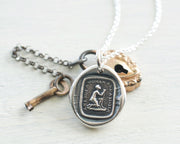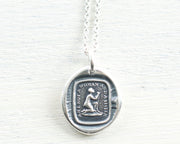am I not a woman and a sister wax seal necklace
A truly special historical wax seal necklace with the image of a kneeling female slave, in chains, surrounded by the words AM I NOT A WOMAN AND A SISTER.
There were a number of female abolitionists using wax seals exactly like this, including Lucretia Mott, one of the most famous female abolitionists of the 19th century. She stamped this image into a pool of wax on almost every letter she wrote, whatever the contents. In a world in which political expression was deemed unladylike, this proved a subtle but powerful way for women to turn polite correspondence into political action.
In 1787 the renowned potter Josiah Wedgwood, a prominent abolitionist, introduced the image of a male slave with the caption AM I NOT A MAN AND A BROTHER. In 1828 a female version was created to reflect the increasing role that women played in the abolitionist movement.
- approximate measurement - 3/4" x just over 5/8" (19mm x 17mm)
- photographed with a US dime for scale
- wax seal charm metal - sterling silver (.925 silver)
- chain - a sterling silver cable chain with a spring ring clasp
- select the necklace chain length or just the charm at checkout
Hand crafted from a Georgian, late 1820’s, engraved yellow glass seal by the artisan William Tassie, a renowned glass and gem engraver and portraitist, living and working in Leicester Square, London. It’s shown in the photo but not available for purchase.
More chains, charm catchers and swivel fobs are available here.
Some photos depict a slightly thicker cable chain which is available here.
The image and motto became the emblem of the anti-slavery movement and appeared on abolitionist paraphernalia circulated in America and Britain in the 1800’s. In addition to wax seals, you might find them on tokens, in pamphlets and books, as well as on bracelets, hairpins, brooches and even snuffboxes. They were very popular at anti-slavery events and sold at the fund-raising fairs.
In the 7th photo is the image of a male slave surrounded by the sentiment AM I NOT A MAN AND A BROTHER available here.
You can find several of these historic seals in the collection at the National Maritime Museum in Greenwich, London. The last photo depicts 4 of the late 1820’s engraved glass seals, by the artisan William Tassie, in their collection.
Impressed with history!












 Pin it
Pin it